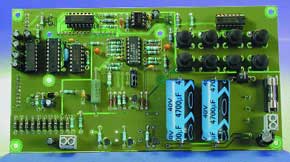Digital Bechtop Power Supply (2)
soldering, sawing and drilling

This is a MEMBER ONLY article. You need a subscription to read this article.
- Unlimited access to online Member Only articles
- 3 new editions Elektor Magazine (digital)
- More than 5000 Gerber files
- 20% member discount on e-books (at elektor.com)
- 10% member discount on Products (at elektor.com)
Available from €5.33 per month.
What is Members Only
Elektor is committed to providing high-quality content on electronics, catering to tens of thousands of paying members. As part of this commitment, Elektor has launched Premium, an initiative that offers exclusive online articles to members sometimes even before they appear in the magazine.
Every day, members can access in-depth articles that showcase the best of Elektor's premium content.
This initiative aims to reward members with early access. Once logged in, members can easily enjoy this exclusive content and engage in discussions about featured projects. While Premium adds to the existing resources available, Elektor will continue to provide a wealth of free information.
Join the Elektor community today to take advantage of Premium and other benefits!
Materials
Gerber file
CAM/CAD data for the PCB referred to in this article is available as a Gerber file. Elektor GREEN and GOLD members can exclusively download these files for free as part of their membership. Gerber files allow a PCB to be produced on an appropriate device available locally, or through an online PCB manufacturing service.
Elektor recommends the Elektor PCB Service service from its business partner Eurocircuits or AISLER as the best services for its own prototypes and volume production.
The use of our Gerber files is provided under a modified Creative Commons license. Creative Commons offers authors, scientists, educators and other creatives the freedom to handle their copyright in a more free way without losing their ownership.
Component list
Resistors:
(* Metal film, 1% tolerance)
R1 = 220Ohm , 5W
R2 = 330Ohm , 0.5W
R3 = 150Ohm
R4 = 100kOhm
R5 = 330Ohm (1kOhm 8)
R6 = 1kOhm , 0.5 W
R7,R18,R23 = 1kOhm *
R8,R17 = 39kOhm *
R9,R10,R13,R14,R40,R41,R43 = 10kOhm
R11,R12 = 47kOhm
R15,R16 = 10kOhm *
R19 = 8kOhm 2
R20,R39 = 1kOhm
R21 = 1kOhm * (0Ohm )
R22 = 18kOhm * (39kOhm *)
R24-R34 = 1Ohm * 0.6W
R35-R38 = 100kOhm *
R42 = 47kOhm
R44 = 3kOhm 3
R45,R46,R47 = 0Ohm 51, 0.5 W (not fitted)
P1 = 10Ohm multiturn preset
P2 = 500Ohm preset H
P3 = 2kOhm 5 preset H
Capacitors:
C1 = 10,000µF 50V (4,700µF 35V), axial
C2 = 470µF 50V, radial
C3,C13,C14,C15,C16,C17 = 10µF 25V, radial
C4,C7,C11 = 100nF, ceramic, 5mm lead pitch
C5 = 10nF, ceramic, 5mm lead pitch
C6 = 1nF, ceramic, 2.5mm lead pitch
C8,C9 = 10µF, tantalum bead
C10 = 4nF7, FKS-2
C12 = 4µ F7 63V, MKS-4
Semiconductors:
D1 = P600D (1N4007)
D2 = zener diode 12V 1.3W
D3,D4,D5,D6 = 1N4148
B1 = B80C5000 (B80C1500)
T1 = BC557B
T2,T3,T4 = TIP142 (1 only)
T5,T6,T7 = BC547B (not fitted)
IC1 = LT1491
IC2 = TLC272
IC3 = PIC16F84A-04P, programmed, order code 000166-42
IC4 = 4066
IC5, IC6 = 74HC164
IC7 = 78L05
IC8 = MAX232
Miscellaneous:
F1 = Fuse, 2A, time lag
F2 = Fuse, 4A, time lag (2A, time lag)
S1-S8 = pushbutton, C&K 3FTL6 + 1S09 22.5, or general-purpose 10x10x20mm, lead pitch 5mm
TR1 = mains transformer, toroid, 24V, 80VA, e.g. UI 39/1721 V, 2571 mA
X1 = ceramic resonator, 4MHz, 3 pins
LCD module 16x1, with backlight
Fuse holder, PCB mount
Fuse holder, chassis mount, (alternatively IEC mains appliance socket with integral fuse)
Two wander sockets (red, black)
Fl1 = mains filter, 2A (not fitted)
K1= 9-way SIL pinheader, with 9-way sub-D socket (female), chassis mount
K2 = 5-way pinheader
K4,K5 = 2-way PCB terminal block, lead pitch 5mm
14-



Discussion (0 comments)